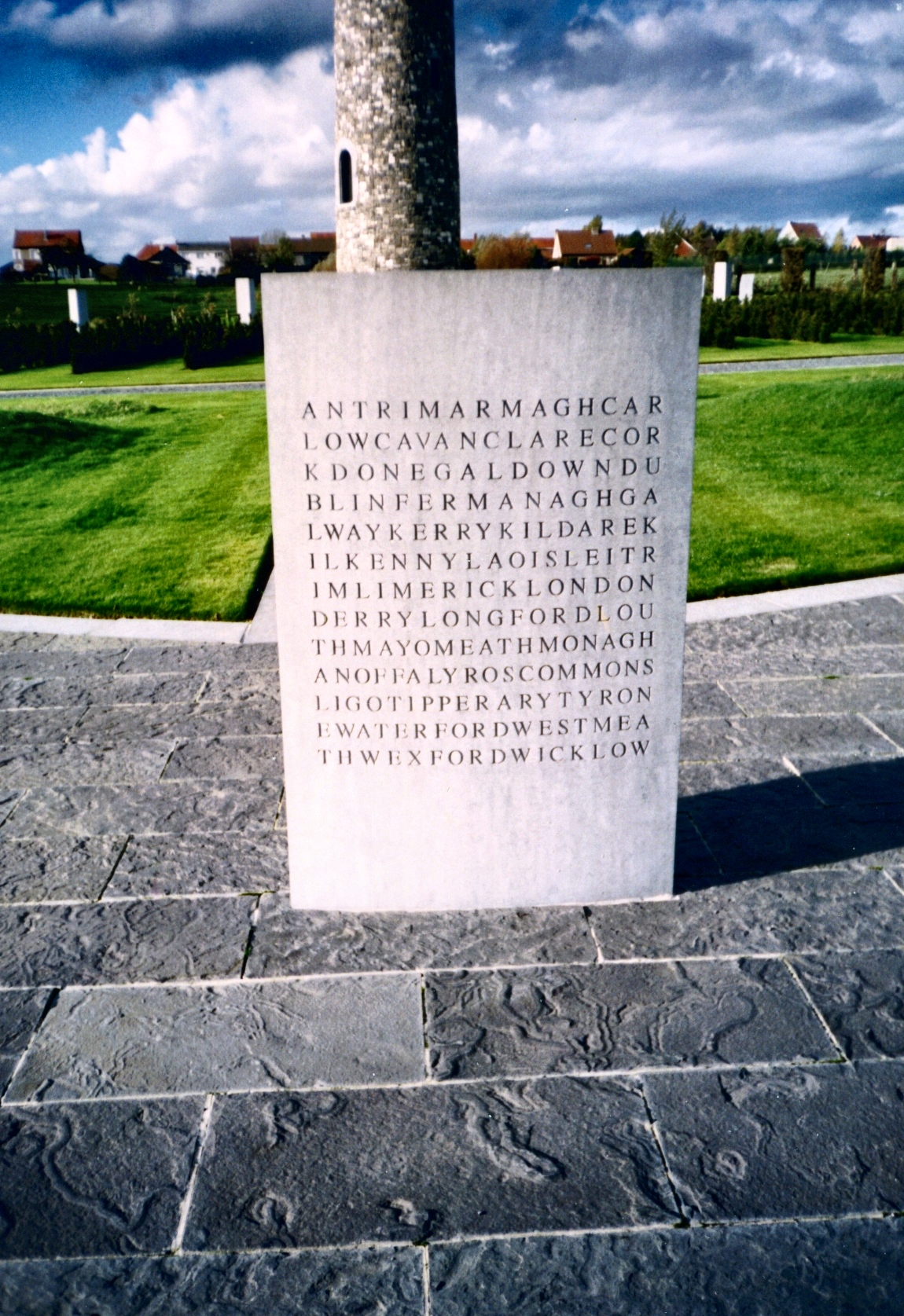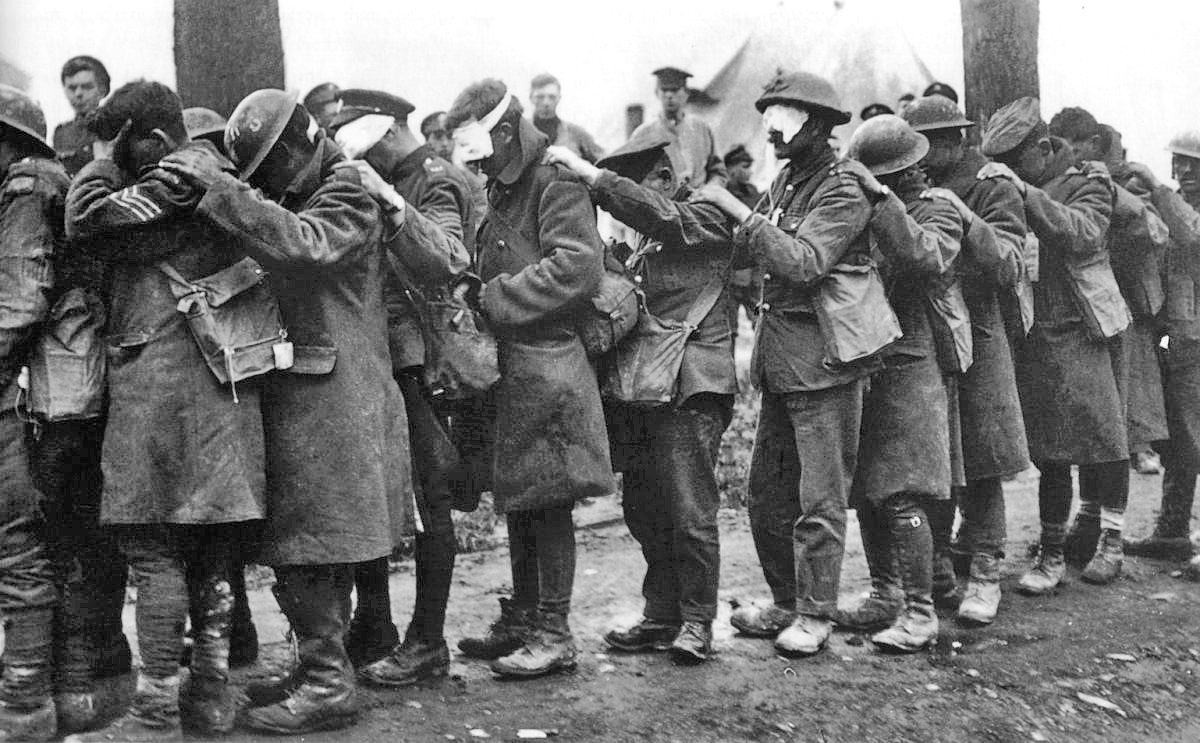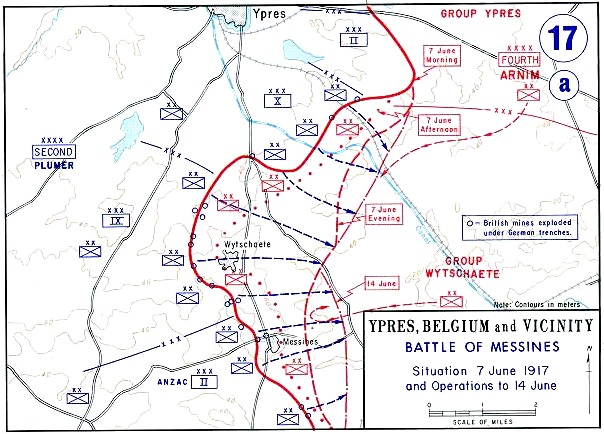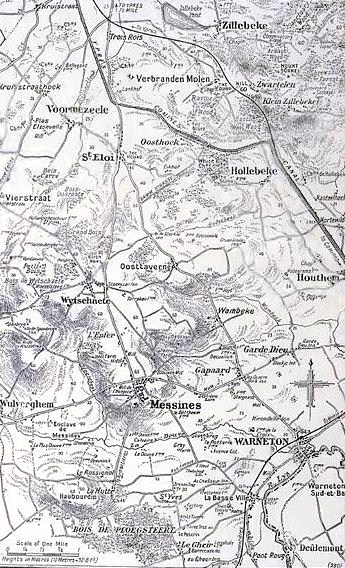|
Mesen Selekta
Mesen (; , historically used in English) is a municipality and city located in the Belgian province of West Flanders. On 1 January 2006, Mesen had a total population of 988. The total area is 3.58 km2 which gives a population density of 276 inhabitants per km2. The municipality comprises only one main settlement, the town of Mesen proper. An exclave to the west of the main territory is surrounded by the municipalities of Heuvelland and Comines-Warneton. Villages neighbouring the municipality: * a. Wijtschate (in the municipality of Heuvelland) * b. Warneton (in the municipality of Comines-Warneton) * c. Ploegsteert (in the municipality of Comines-Warneton) Mesen is the smallest city in Belgium. It is a municipality with language facilities. Mesen is twinned with Featherston in New Zealand in part due to the location of the New Zealand World War I Memorial, which has annual Anzac Day commemorations on 25 April. History In 1062, Adela, wife of Baldwin the Pius, ... [...More Info...] [...Related Items...] OR: [Wikipedia] [Google] [Baidu] |
Arrondissement Of Ypres
{{WestFlanders-geo-stub ...
The Arrondissement of Ypres (; ) is one of the eight administrative arrondissements near the Province of West Flanders, Belgium. It is both an administrative and a judicial arrondissement. However, the Judicial Arrondissement of Ypres also comprises the municipalities of Staden and Moorslede in the Arrondissement of Roeselare. Municipalities The Administrative Arrondissement of Ypres consists of the following municipalities: * Heuvelland * Langemark-Poelkapelle *Mesen *Poperinge *Vleteren *Wervik *Ypres *Zonnebeke References Ypres Ypres ( ; ; ; ; ) is a Belgian city and municipality in the province of West Flanders. Though the Dutch name is the official one, the city's French name is most commonly used in English. The municipality comprises the city of Ypres/Ieper ... [...More Info...] [...Related Items...] OR: [Wikipedia] [Google] [Baidu] |
Messines Ridge (New Zealand) Memorial
The Messines Ridge (New Zealand) Memorial is a World War I war memorial, memorial, located in Messines Ridge British Cemetery, near the town of Mesen, Belgium. The memorial lists 827 officers and men of the New Zealand Expeditionary Force with no known grave who died in or near Messines in 1917 and 1918.Messines Ridge (New Zealand) Memorial Commonwealth War Graves Commission, retrieved 22 February 2011 This period included the Battle of Messines (1917), Battle of Messines. History The memorial, designed by the English architect Charles Holden, is one of seven such memorials on the Western Front (World War I), Western Front to the missing dead from New Zealand. The others are located at Buttes New British Cemetery (New Zealand) Memorial, Buttes New British Cemetery, Ca ...[...More Info...] [...Related Items...] OR: [Wikipedia] [Google] [Baidu] |
Irish Peace Park
The Island of Ireland Peace Park and its surrounding park (), also called the Irish Peace Park () or Irish Peace Tower in Messines, near Ypres in Flanders, Belgium, is a war memorial to the soldiers of the island of Ireland who died, were wounded or are missing from World War I, during Ireland's involvement in the conflict. The tower memorial is close to the site of the June 1917 battle of Messines Ridge, during which the 16th (Irish) Division fought alongside the 36th (Ulster) Division. Development Because of the events of the Easter Rising in 1916 and the partition of Ireland under the Anglo-Irish Treaty in 1922 and the Irish Civil War that followed it, little was done in the Republic of Ireland to commemorate the Irish dead from the Great War or World War II. Those countries who were engaged in the Great War all preserve the memory of their fallen soldiers with national monuments in the Western Front area. That led to some ill feelings in the already-crowded emotions of th ... [...More Info...] [...Related Items...] OR: [Wikipedia] [Google] [Baidu] |
Battle Of The Lys (1918)
The Battle of the Lys, also known as the Fourth Battle of Ypres, was fought from 7 to 29 April 1918 and was part of the German spring offensive in Flanders during the First World War. It was originally planned by General Erich Ludendorff as Operation George but was reduced to Operation Georgette, with the objective of capturing Ypres, forcing the British forces back to the Channel ports and out of the war. In planning, execution and effects, Georgette was similar to (although smaller than) Operation Michael, earlier in the Spring Offensive. Background Strategic developments The German attack zone was in Flanders, from about east of Ypres in Belgium to east of Béthune in France, about south. The front line ran from north-north-east to south-south-west. The Lys River, running from south-west to north-east, crossed the front near Armentières in the middle of this zone. The front was held by the Belgian Army in the far north, by the British Second Army (under Plumer) ... [...More Info...] [...Related Items...] OR: [Wikipedia] [Google] [Baidu] |
Mines In The Battle Of Messines (1917)
Several underground explosive charges were fired during the First World War at the start of the Battle of Messines (1917), Battle of Messines . The battle was fought by the British Second Army (United Kingdom), Second Army (General Sir Herbert Plumer, 1st Viscount Plumer, Herbert Plumer) and the German 4th Army (German Empire), 4th Army (General Friedrich Sixt von Armin) near Mesen (''Messines'' in French language, French, also used in English language, English and German language, German) in Belgian West Flanders. The mines, secretly planted and maintained by tunnelling companies of the Royal Engineers beneath the German front position, killed many German soldiers and created craters. The explosions rank among the Largest artificial non-nuclear explosions, largest non-nuclear explosions. Before the attack, General Sir Charles Harington (British Army officer, born 1872), Charles Harington, Chief of Staff of the Second Army, told the press, "Gentlemen, I don't know whether ... [...More Info...] [...Related Items...] OR: [Wikipedia] [Google] [Baidu] |
Battle Of Messines (1917)
The Battle of Messines (7–14 June 1917) was an attack by the British Second Army (General Sir Herbert Plumer), on the Western Front, near the village of Messines ( Dutch: Mesen) in West Flanders, Belgium, during the First World War. The Nivelle Offensive in April and May had failed to achieve its more grandiose aims, had led to the demoralisation of French troops and confounded the Anglo-French strategy for 1917. The attack forced the Germans to move reserves to Flanders from the Arras and Aisne fronts, relieving pressure on the French. The British tactical objective was to capture the German defences on the ridge, which ran from Ploegsteert Wood (Plugstreet to the British) in the south, through Messines and Wytschaete to Mt Sorrel, depriving the German 4th Army of the high ground. The ridge gave commanding views of the British defences and back areas of Ypres to the north, from which the British intended to conduct the Northern Operation, an advance to Passchendaele ... [...More Info...] [...Related Items...] OR: [Wikipedia] [Google] [Baidu] |
Battle Of Messines (1914)
The Battle of Messines was fought in October 1914 between the armies of the German Empire against the British Empire and France, as part of what came to be called the Race to the Sea: reciprocal attempts by the German and Entente armies to attack beyond the northern flank of their opponent. The attempts to turn the northern flank led to several meeting engagements until the North Sea left neither side with a flank to aim at. The battle was fought between the river Douve and the Comines–Ypres canal. Background Strategic developments From the belligerents had made reciprocal attempts to turn the northern flank of their opponent. Joseph Joffre, the head of (Chief of the General Staff) ordered the French Second Army to move to the north of the Sixth Army, by transferring by rail from eastern France from Erich von Falkenhayn, Chief of (the German General Staff) ordered the German 6th Army to move from the German–French border to the northern flank on 17 September. By the ne ... [...More Info...] [...Related Items...] OR: [Wikipedia] [Google] [Baidu] |
World War I
World War I or the First World War (28 July 1914 – 11 November 1918), also known as the Great War, was a World war, global conflict between two coalitions: the Allies of World War I, Allies (or Entente) and the Central Powers. Fighting took place mainly in European theatre of World War I, Europe and the Middle Eastern theatre of World War I, Middle East, as well as in parts of African theatre of World War I, Africa and the Asian and Pacific theatre of World War I, Asia-Pacific, and in Europe was characterised by trench warfare; the widespread use of Artillery of World War I, artillery, machine guns, and Chemical weapons in World War I, chemical weapons (gas); and the introductions of Tanks in World War I, tanks and Aviation in World War I, aircraft. World War I was one of the List of wars by death toll, deadliest conflicts in history, resulting in an estimated World War I casualties, 10 million military dead and more than 20 million wounded, plus some 10 million civilian de ... [...More Info...] [...Related Items...] OR: [Wikipedia] [Google] [Baidu] |
Saint Sidronius
Saint Sidronius (died ) was a Roman martyr. His life is confused with a French saint of the same name. His feast date is 8 September or 11 July. Church The village of Saint-Cydroine in the commune of Laroche-Saint-Cydroine near Sens in Yonne, France, is named after the saint. It is said that Sidronius was martyred here by the Romans, and a spring here with miraculous powers was a place of pilgrimage in the Middle Ages. The Saint Cydroine Church is an 11th- or 12th-century Romanesque church with an octagonal tower in the village dedicated to the saint. It was founded by the abbey of La Charité-sur-Loire. Monks of Ramsgate account The Monks of Ramsgate wrote in their ''Book of Saints'' (1921), Baring-Gould's account Sabine Baring-Gould (1834–1924) wrote in his ''Lives of the Saints'' (1897), Butler's account The hagiographer Alban Butler Alban Butler (13 October 171015 May 1773) was an English Roman Catholic priest and hagiography, hagiographer. Born in Northamptonsh ... [...More Info...] [...Related Items...] OR: [Wikipedia] [Google] [Baidu] |
Flanders
Flanders ( or ; ) is the Dutch language, Dutch-speaking northern portion of Belgium and one of the communities, regions and language areas of Belgium. However, there are several overlapping definitions, including ones related to culture, language, politics, and history, and sometimes involving neighbouring countries. The demonym associated with Flanders is Flemings, Fleming, while the corresponding adjective is Flemish people, Flemish, which can also refer to the collective of Dutch dialects spoken in that area, or more generally the Belgian variant of Standard Dutch. Most Flemings live within the Flemish Region, which is a federal state within Belgium with its own elected government. However, like Belgium itself, the official capital of Flanders is the City of Brussels, which lies within the Brussels, Brussels-Capital Region, not the Flemish Region, and the majority of residents there are French speaking. The powers of the Flemish Government in Brussels are limited mainly ... [...More Info...] [...Related Items...] OR: [Wikipedia] [Google] [Baidu] |
Baldwin IV, Count Of Flanders
Baldwin IV (980 – 30 May 1035), called the Bearded, was the count of Flanders from 987 until his death. Baldwin IV was the son of Count Arnulf II of Flanders (c. 961 — 987) and Rozala of Italy (950/60 – 1003), of the House of Ivrea.Detlev Schwennicke, ''Europäische Stammtafeln: Stammtafeln zur Geschichte der Europäischen Staaten'', Neue Folge, Band II (Marburg, Germany: J. A. Stargardt, 1984), Tafel 5 He succeeded his father as Count of Flanders in 987, but with his mother Rozala as the regent until his majority. In contrast to his predecessors Baldwin turned his attention eastward, leaving the southern part of his territory in the hands of his vassals the counts of Guînes, Hesdin, and St. Pol. To the north of the county Baldwin was given Zeeland as a fief by the Holy Roman Emperor Henry II, while on the right bank of the Scheldt river he received Valenciennes (1013) and parts of the Cambresis as well as Saint-Omer and the northern Ternois (1020).Heather J Tanner, ''F ... [...More Info...] [...Related Items...] OR: [Wikipedia] [Google] [Baidu] |
Anzac Day
Anzac Day is a national day of remembrance in Australia, New Zealand and Tonga that broadly commemorates all Australians and New Zealanders "who served and died in all wars, conflicts, and peacekeeping operations" and "the contribution and suffering of all those who have served". Observed on 25 April each year, Anzac Day was originally devised to honour the members of the Australian and New Zealand Army Corps (ANZAC) who served in the Gallipoli campaign, their first engagement in the First World War (1914–1918). History Anzac Day marks the anniversary of the first campaign that led to major casualties for Australian and New Zealand forces during the First World War. The acronym ANZAC stands for Australian and New Zealand Army Corps, whose soldiers were known as Anzacs. Anzac Day remains one of the most important national occasions of both Australia and New Zealand; however, the ceremonies and their meanings have changed significantly since 1915. According to Martin Crotty ... [...More Info...] [...Related Items...] OR: [Wikipedia] [Google] [Baidu] |






